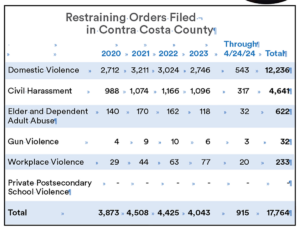Restraining Orders Everything You Need to Know
The July 2024 issue highlights the different types of civil restraining orders available in California. Though many practitioners are familiar with Domestic Violence Restraining Orders (DVROs) and Civil Harassment Restraining Orders (CHROs), the magazine’s Editorial Board also wished to bring attention to the other types of restraining orders available to our clients and community. We were able to acquire filing statistics from the Superior Court in Contra Costa County pertaining to the various types of restraining orders. As the data below shows, DVROs are the most frequently requested, encompassing nearly 70 percent of all the types, with CHROs encompassing 26 percent. Unfortunately, statistics are not maintained for the disposition across case types.
 The Editorial Board also hopes that this issue will provide Contra Costa County attorneys with information on how to help their clients and members of our community, when situations arise where a restraining order may be an appropriate remedy. First, Rachel Margolis Chapman has prepared a chart of the types of civil restraining orders available, who may ask for it, elements/definition, burden of proof to be met, duration, authorizing statutes, and how to obtain them in Contra Costa. This chart is a keeper! We encourage you to save it in your files.
The Editorial Board also hopes that this issue will provide Contra Costa County attorneys with information on how to help their clients and members of our community, when situations arise where a restraining order may be an appropriate remedy. First, Rachel Margolis Chapman has prepared a chart of the types of civil restraining orders available, who may ask for it, elements/definition, burden of proof to be met, duration, authorizing statutes, and how to obtain them in Contra Costa. This chart is a keeper! We encourage you to save it in your files.
The Contra Costa Family Justice Center (FJC) is a one-stop shop serving families affected by domestic violence, sexual assault, child abuse, elder abuse and human trafficking. If you know someone who is a victim of interpersonal violence and they are unsure of what to do, you can start by having them contact a navigator at the FJC. Natalie Oleas, the Central Center’s Director, and a client, Sharon Sobotta, share Sharon’s experience with domestic violence and how the FJC helped her in her time of need. Of note, the FJC is seeking donations and volunteers from our legal community, and would love to hear from you.
Judge Anita Santos (Ret.), now a neutral with ADR Services, Inc., provides a quick primer on the new Family Code section 6309, effective January 2024. Her article discusses the legislative intent, the discretion that the court retains to control the proceedings and includes key points, practice tips and resources.
Criminal defense and restraining order attorney Jo-Anna Nieves discusses electronic harassment and special issues that arise, such as venue and jurisdiction. How has the law kept up with our increasingly mobile society, where data is more available than ever?
Trusts and estates litigation attorney Alyssa Daatio explains the tools available to protect elderly and dependent adults, which include conservatorships and remedies against abuse, neglect, isolation, or exploitation.
Finally, criminal defense and family law attorney, Danielle Jones highlights the differences between criminal protective orders and domestic violence restraining orders and potential consequences or tactics that may be applicable.
While gun violence and workplace violence restraining orders are not specifically covered by articles in this issue, it is important to know of their existence as a possible remedy to seek, should the unthinkable arise. The 2014 Isla Vista shooting, resulting in the deaths of six people and injury of 14 others near the UC Santa Barbara campus, helped prompt the passage of the Gun Violence Restraining Order law. Friends and family had feared the shooter was dangerous, but law enforcement was unable to remove firearms from his possession. California became the first state to pass a law authorizing such a restraining order in 2014.1
Workplace violence restraining order is another area of law that continues to develop. Currently, employers are only able to seek protection to protect against violence, threats of violence or stalking. Effective January 1, 2025, employers will also be able to seek protection for an employee being harassed by an individual. In the past, the harassed individual could only pursue a restraining order on their own. “Harassment” is defined as “a knowing and willful course of conduct directed at a specific person that seriously alarms, annoys, or harasses the person, and that serves no legitimate purpose.” The course of conduct must “be that which would cause a reasonable person to suffer substantial emotional distress, and must actually cause substantial emotional distress.” The courts may not issue restraining orders for actions “that are constitutionally protected, protected by the National Labor Relations Act … or otherwise protected by Section 527.3 or any other provision of law.” As of July 1, 2024, most employers must also establish, implement, and maintain an effective workplace violence prevention plan.2
Restraining orders are a rich area of law in which many practitioners engage. Even if you are not among those ranks, it behooves you to have a working knowledge of the information contained in this issue. We hope that you will find it educational and useful.
1. Tomsich, E.A., Pear, V.A., Schleimer, J.P. et al. The origins of California’s gun violence restraining order law: a case study using Kingdon’s multiple streams framework. BMC Public Health 23, 1275 (2023). https://doi.org/10.1186/s12889-023-16043-6
2. Sen. Bill No. 553 (2023-2024 Reg. Sess.